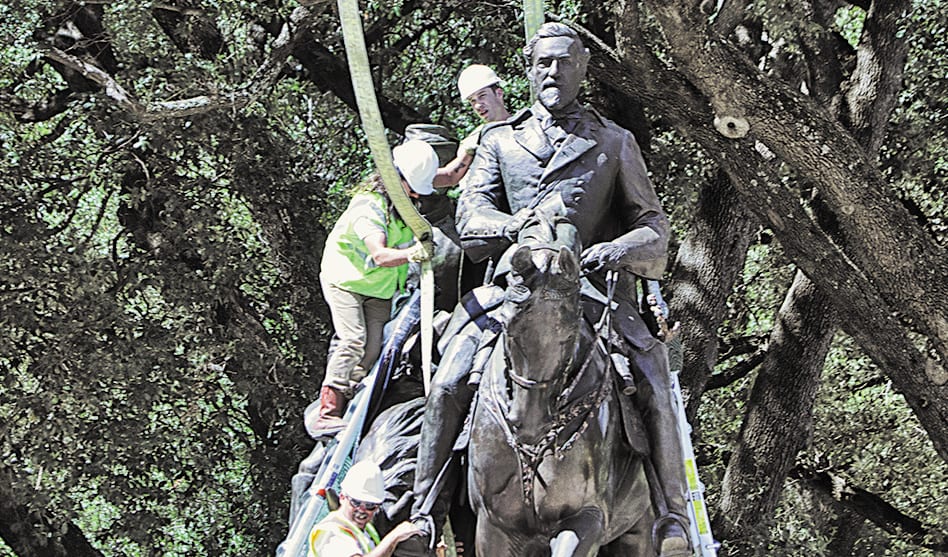The time has come to make these monuments a part of the past, and move forward together
 The debate about Confederate monuments is about to heat up in Dallas again as the city council considers the fate of public symbols of the Civil War. The solution should be obvious to all at this point, but like all things political it probably will not be.
The debate about Confederate monuments is about to heat up in Dallas again as the city council considers the fate of public symbols of the Civil War. The solution should be obvious to all at this point, but like all things political it probably will not be.
On the agenda is the final disposition of the Robert E. Lee statue removed last fall from Oak Lawn Park (formerly known as Lee Park), the fate of a Confederate memorial in downtown Dallas near City Hall, and whether to rename streets memorializing Confederate elite such as Lee.
As always there are strong emotions on both sides of the issue, and some good — as well as bad — intentions in the debate.
Many proponents maintain that the memorials are simply an accurate reflection of Texas history, and that they do not promote injustice or glorify the practice of slavery. Opponents disagree, saying that the memorials remind African-Americans of the injustice and the cruelty their ancestors endured. Some proponents, unfortunately, are simply racists, and they resent any efforts to appease the descendants of slaves.
As a native Texan, I grew up with these symbols, and I never thought much about what they meant to others. The Lee statue represented nothing more to me than a couple of soldiers on horses, naïve as that might be. I initially resisted the removal of public art that had existed from before my birth — until August 2017, when I saw television news coverage of the riot in Charlottesville.
Afterwards, I decided that I couldn’t support any position favored by white supremacists, especially when it could lead to violence.
My resolve against the memorials deepened when I asked a 61-year-old African-American lesbian and LGBT activist I know if the sight of these memorials upset her. She said that in fact, the sight of the monument in Lee Park offended her deeply, to the point of intimidation.
“Over the years when I’ve gone to events there and back in the day when I spoke at a couple of Pride rallies there, I always made sure to enter and stand on the side away from the statue,” she told me. “It gave me the creeps and made me feel sick to see it.
“I’m an old chick. One of my most vivid memories is being in the car in Alabama with my family and all of a sudden five huge horses with Ku Klux Klansmen surrounded us to escort us out of town,” she recalled. “So frightening — it was the first time I ever saw my parents scared. So remnants and reminders glorifying those who thought slavery was a good thing and that black people were less than human have never left me with a warm fuzzy feeling.”
She ended by pointing out that it was an easy answer of yes for her. It should have been easy for me, too. But sometimes I need to be hit on the head to see the light.
How ironic that LGBT and AIDS activism would be rooted in a park dedicated to the memory of a defender of slavery in the South.
Dallas city staff and the members of the Confederate Monuments Task Force appointed to study the issue agree that the Lee statue, erected in 1936 and now valued at $1 million, should be moved from where it is stored at the Naval Air Station in Grand Prairie to the Texas Civil War Museum in White Settlement, with the addition of language to clarify its historical significance.
The other proposals are more problematic. City staff recommends keeping the downtown memorial but adding language to it, as well, to point out its historical significance. But the task force wants to move it to a museum.
Moving it would be expensive, but I doubt anything less will put the controversy to rest. Leaving it in place in any form will likely perpetuate conflict in a city already beset by distrust between the races.
Renaming the streets will also be expensive and confusing, as it would require re-identification of streets on maps, and residents and businesses would be required to change addresses on all of their accounts. But other streets, such as parts of South Central Expressway (now Cesar Chavez Boulevard) and Industrial Boulevard (now Riverfront Boulevard) in
Dallas underwent name changes, so it is not without precedent
My African-American friend said the opposition to making the changes, especially by those who claim not to be bigots or apologists for slavery, leaves her “depressed, frightened and discouraged” every day of her life.
“It wears me out fighting the same fight or trying to educate about the same issue all my life,” she said.
Everyone is worn out, and it is time to let go of the past.
It seems more logical to make all of the changes now, rather than partially addressing the issue. The controversy will only become worse in the years to come if there is a delay. It is time to look toward the future and consider how life can be made better for everyone.
David Webb is a veteran journalist with more than four decades of experience, including a stint as a staff reporter for Dallas Voice. In 2016, he received the Press Club of Dallas’ Legends Award, bestowed in large part for his work with Dallas Voice. He now lives on Cedar Creek Lake and writes for publications nationwide.
















